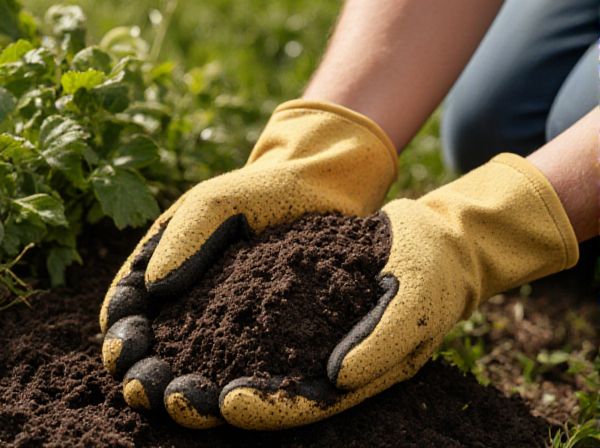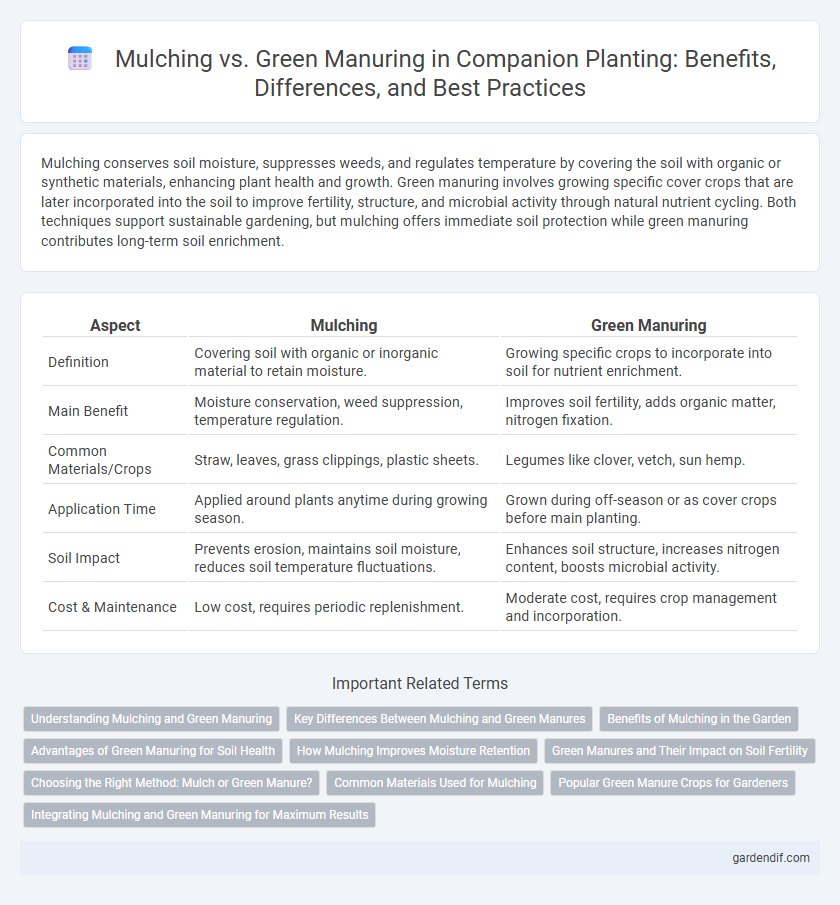
Mulching vs Green manuring Illustration
Mulching conserves soil moisture, suppresses weeds, and regulates temperature by covering the soil with organic or synthetic materials, enhancing plant health and growth. Green manuring involves growing specific cover crops that are later incorporated into the soil to improve fertility, structure, and microbial activity through natural nutrient cycling. Both techniques support sustainable gardening, but mulching offers immediate soil protection while green manuring contributes long-term soil enrichment.
Table of Comparison
| Aspect | Mulching | Green Manuring |
|---|---|---|
| Definition | Covering soil with organic or inorganic material to retain moisture. | Growing specific crops to incorporate into soil for nutrient enrichment. |
| Main Benefit | Moisture conservation, weed suppression, temperature regulation. | Improves soil fertility, adds organic matter, nitrogen fixation. |
| Common Materials/Crops | Straw, leaves, grass clippings, plastic sheets. | Legumes like clover, vetch, sun hemp. |
| Application Time | Applied around plants anytime during growing season. | Grown during off-season or as cover crops before main planting. |
| Soil Impact | Prevents erosion, maintains soil moisture, reduces soil temperature fluctuations. | Enhances soil structure, increases nitrogen content, boosts microbial activity. |
| Cost & Maintenance | Low cost, requires periodic replenishment. | Moderate cost, requires crop management and incorporation. |
Understanding Mulching and Green Manuring
Mulching involves covering the soil with organic or inorganic materials such as straw, leaves, or plastic to conserve moisture, suppress weeds, and improve soil temperature. Green manuring is the practice of growing specific cover crops like legumes or clover, which are then plowed into the soil to enhance fertility by adding organic matter and nitrogen. Both practices promote sustainable soil health but serve different functional roles in companion planting systems.
Key Differences Between Mulching and Green Manures
Mulching involves covering the soil surface with organic or inorganic materials to retain moisture, regulate temperature, and suppress weeds, while green manuring refers to growing specific crops that are later incorporated into the soil to enhance fertility and organic matter content. Mulching primarily provides a physical barrier that conserves soil health, whereas green manures actively improve soil nutrient levels through nitrogen fixation and decomposition of biomass. Both techniques support sustainable agriculture but differ significantly in their mechanism and impact on soil biology and nutrient cycling.
Benefits of Mulching in the Garden
Mulching improves soil moisture retention by reducing evaporation, which supports healthier plant growth and reduces irrigation needs in the garden. It suppresses weed growth by blocking sunlight, minimizing competition for nutrients and space with companion plants. Organic mulches also enhance soil fertility as they decompose, enriching the soil with essential nutrients and beneficial microbial activity.
Advantages of Green Manuring for Soil Health
Green manuring significantly enhances soil health by increasing organic matter, improving soil structure, and promoting microbial activity, which boosts nutrient availability and retention. It enriches the soil with essential nutrients, particularly nitrogen, due to the nitrogen-fixing properties of leguminous cover crops used in green manuring. This sustainable practice also helps reduce soil erosion and suppresses weeds, contributing to long-term soil fertility and ecosystem balance.
How Mulching Improves Moisture Retention
Mulching enhances soil moisture retention by creating a protective layer that reduces evaporation and moderates soil temperature. Organic mulches like straw, wood chips, or compost break down slowly, improving soil structure and increasing water infiltration. This process helps maintain consistent moisture levels, benefiting companion plants by reducing water stress and promoting healthier growth.
Green Manures and Their Impact on Soil Fertility
Green manures, such as legumes and cover crops, significantly enhance soil fertility by fixing atmospheric nitrogen and increasing organic matter content. Their deep root systems improve soil structure, promote microbial activity, and reduce erosion, leading to long-term soil health benefits. Incorporating green manures into crop rotations supports sustainable agriculture by naturally enriching nutrient availability and boosting soil productivity.
Choosing the Right Method: Mulch or Green Manure?
Choosing the right soil improvement method depends on your garden's specific needs and goals. Mulching conserves moisture, suppresses weeds, and gradually enriches the soil with organic matter, making it ideal for maintaining soil health and preventing erosion. Green manuring improves soil fertility by fixing nitrogen and boosting microbial activity, especially beneficial for nutrient-deficient or heavily cultivated soils.
Common Materials Used for Mulching
Common materials used for mulching include organic options like straw, wood chips, shredded leaves, and grass clippings, which help retain soil moisture and suppress weeds. Inorganic mulches such as black plastic, landscape fabric, and rubber mulch provide durable ground coverage and can regulate soil temperature effectively. Choosing the appropriate mulch material depends on factors like crop type, climate conditions, and desired soil health benefits in companion planting.
Popular Green Manure Crops for Gardeners
Popular green manure crops for gardeners include legumes such as clover, vetch, and beans, which enrich soil nitrogen levels through biological fixation. Non-leguminous options like buckwheat and rye improve soil structure and suppress weeds while providing organic matter. Selecting the appropriate green manure crop depends on garden goals, climate, and soil conditions to maximize growth benefits.
Integrating Mulching and Green Manuring for Maximum Results
Integrating mulching and green manuring enhances soil fertility by combining organic matter retention with nutrient-rich biomass incorporation. Mulching conserves moisture, suppresses weeds, and stabilizes soil temperature, while green manuring enriches soil nitrogen levels and improves microbial activity. This synergistic approach optimizes crop yield, promotes sustainable agriculture, and boosts long-term soil health.
Mulching vs Green manuring Infographic

 gardendif.com
gardendif.com